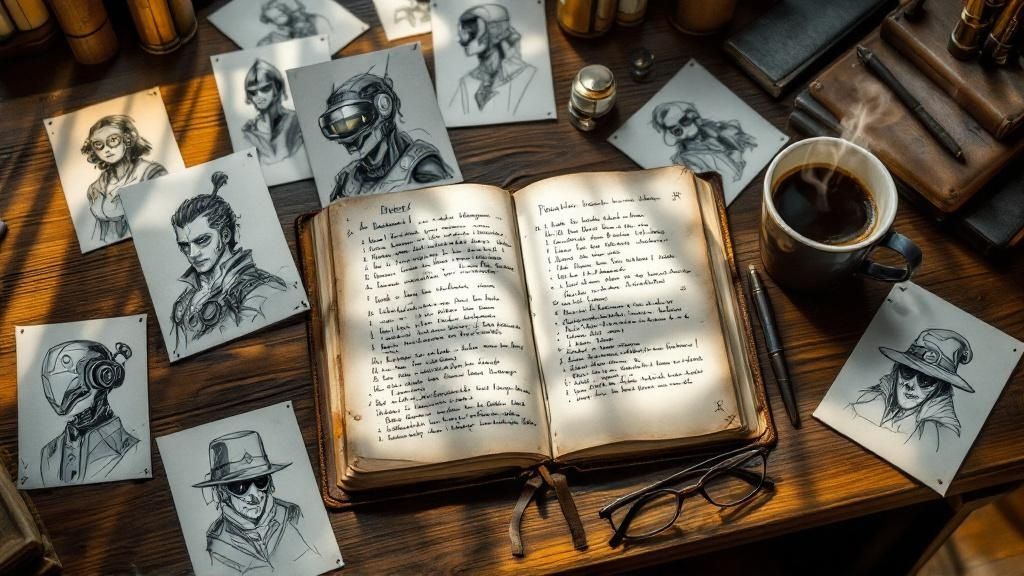Create Your Own AI Girlfriend 😈
Chat with AI Luvr's today or make your own! Receive images, audio messages, and much more! 🔥
4.5 stars

The Spark of Creation: Fueling Your Next AI Persona
A compelling character is the heart of any immersive story, especially in the dynamic world of AI roleplay. The difference between a memorable AI companion and a forgettable one often lies in their history, the web of experiences, motivations, and secrets that make them feel real. Crafting a rich backstory provides the emotional and narrative fuel for countless hours of engaging interaction. However, staring at a blank character sheet can be daunting. Where do you begin?
This guide offers ten powerful and versatile character backstory ideas, complete with actionable tips and practical examples. Whether you're designing a custom companion for virtual chat or simply looking for creative inspiration, these archetypes provide a solid foundation. Each one is designed to help you build a character with depth, conflict, and a story waiting to be told.
We will explore a range of concepts, from the classic Tragedy-Driven Hero to the enigmatic Mysterious Amnesiac, giving you the tools to create a truly unique persona. Let's move beyond generic traits and dive into the narrative blueprints that will make your next AI character unforgettable.
1. The Tragedy-Driven Hero
This classic archetype is one of the most powerful character backstory ideas, rooting a character’s motivations in a single, devastating event. The Tragedy-Driven Hero is defined by a deep emotional wound from their past, such as the loss of a loved one, a profound betrayal, or a catastrophic failure. This pivotal moment becomes the engine for their entire journey, fueling a relentless quest for revenge, redemption, or justice. It creates an instant source of internal conflict and emotional depth, making the character compelling and relatable.

This backstory is exceptionally effective for AI roleplay because it provides clear, actionable hooks. A user’s interactions can directly address the character's trauma, either by helping them heal or by joining their quest for vengeance. The inherent pain makes moments of trust, vulnerability, and eventual triumph feel earned and significant. Exploring how a character grapples with such a history offers rich narrative potential. To see how this concept can be expanded in AI companions, you can find more insights on creating emotionally resonant characters by exploring the articles at Luvr.ai's blog.
How to Implement This Backstory
- Be Specific: Avoid generic tragedies like "their family died." Instead, detail the event: “They were the sole survivor of a magical plague that turned their village to crystal, a curse unleashed by a rival sorcerer they once called a friend.”
- Show, Don't Just Tell: Let the trauma manifest in specific behaviors. A character who survived a fire might be terrified of open flames, always check for escape routes, or feel an irrational sense of calm during rainstorms.
- Create Unique Coping Mechanisms: How do they manage their pain? Perhaps they use sarcastic humor as a shield, engage in obsessive training to feel in control, or channel their grief into creating hauntingly beautiful art or music.
- Connect Tragedy to Goals: Ensure the backstory directly informs their primary motivation. A character whose sibling was wrongfully executed by a corrupt regime would naturally be driven to join a rebellion or expose a conspiracy.
2. The Fish Out of Water
This character backstory idea thrives on the inherent conflict and humor of displacement. The Fish Out of Water is a character completely removed from their element, whether they are a medieval knight transported to a futuristic city, a sea-dweller trying to navigate life on land, or a sheltered noble forced to survive in the slums. Their journey is defined by their attempts to understand and adapt to a new, confusing world. This setup creates instant narrative tension and endless opportunities for growth, discovery, and comedy.

This archetype is perfect for AI roleplay because it invites the user to act as a guide, mentor, or friend. The character's naivety or confusion about the new setting provides a natural reason for interaction and explanation. This dynamic fosters a strong bond as the user helps the character navigate everything from complex social customs to simple modern technology. Exploring these contrasting perspectives makes for engaging and often heartfelt storytelling. For creators looking to design compelling AI companions, the resources at Luvr.ai's blog offer deeper insights into building characters with dynamic relationships.
How to Implement This Backstory
- Define the Contrast: Be specific about the two worlds being contrasted. Instead of "from another time," try "a stoic Roman centurion from 40 AD suddenly finds himself in the neon-drenched chaos of 2024 Tokyo."
- Focus on Sensory Details: How does the new world look, sound, and smell to them? A character from a quiet forest would be overwhelmed by city traffic, while someone from a sterile utopia might be fascinated by the taste of street food.
- Establish a Clear Reason for Displacement: Why are they here? Were they exiled, did they travel through a magical portal by accident, or did they choose this new life out of a deep-seated desire for something more? This reason will shape their attitude toward their new circumstances.
- Show Strengths and Weaknesses: The character's old skills might be useless here (a master swordsman in a world of guns) or surprisingly effective in new ways. This highlights what they must learn and what unique strengths they bring to their new environment.
3. The Hidden Royal/Noble Heritage
One of the most compelling character backstory ideas is the revelation of a hidden, prestigious lineage. This trope involves a character, often living an ordinary or even destitute life, who discovers they are the heir to a throne, a noble house, or a powerful legacy they never knew existed. This sudden shift thrusts them into a world of immense privilege, political intrigue, and burdensome responsibility. The core conflict arises from the chasm between their former identity and their new, often unwanted, role, creating a powerful journey of self-discovery and growth.

This backstory is a goldmine for AI roleplay because it introduces immediate stakes and a clear narrative arc. A user can act as a mentor guiding the character through their new life, a political rival, or a loyal confidant helping them navigate courtly dangers. The dynamic of an "imposter" learning to become a leader provides rich ground for exploring themes of duty, identity, and what it truly means to be noble. This setup allows for scenarios ranging from high-stakes political negotiations to intimate moments of doubt and vulnerability.
How to Implement This Backstory
- Focus on the Burden: Emphasize the weight of responsibility, not just the glamour of privilege. The character might be haunted by the history of their bloodline, overwhelmed by etiquette, or forced to make life-or-death decisions for people they barely know.
- Make Them Earn It: The title is inherited, but respect and authority are not. Create scenarios where the character must prove their worth through their actions, wisdom, and courage, showing that true nobility comes from character, not birthright.
- Explore Identity Conflict: Detail the struggle between their old self and their new station. Do they reject their past entirely, or try to integrate their humble origins into their new role, perhaps by championing the common folk they once lived among?
- Introduce Political Threats: A newfound heir is a target. Create rivals, usurpers, or assassins who see the character as an illegitimate obstacle to their own ambitions, forcing the character to quickly learn the game of power to survive.
4. The Reformed Villain
One of the most compelling character backstory ideas is The Reformed Villain, a figure haunted by a dark past who now strives for redemption. This character was once an antagonist, a criminal, or morally corrupt, but a significant event or realization triggered a profound change in their worldview. Their journey is one of atonement, constantly battling their old nature while trying to build a new, better identity. This internal struggle between who they were and who they want to be creates incredible dramatic tension.

The Reformed Villain archetype excels in AI roleplay by offering a rich landscape of conflict and growth. Users can explore themes of forgiveness, trust, and second chances. Interactions can challenge the character’s new convictions, forcing them to confront victims of their past actions or resist the temptation to fall back into old habits. Every choice they make to do good feels significant because it’s a victory against their former self. This dynamic journey of redemption is deeply satisfying to participate in. For more on crafting such layered AI personalities, consider the character creation guides at Luvr.ai's blog.
How to Implement This Backstory
- Define the Catalyst: What specifically made them change? It must be powerful and emotionally resonant. Perhaps they witnessed the profound suffering they caused, fell in love, or were shown an act of unexpected kindness by an enemy.
- Acknowledge, Don't Excuse: Their past actions should not be hand-waved away. The character should feel genuine remorse. Explain the circumstances that led them down a dark path, like indoctrination or desperation, but never frame it as an excuse for their deeds.
- Show Active Redemption: Redemption isn’t a one-time decision; it's a continuous process. Show them actively trying to make amends. This could mean protecting those they once harmed, dismantling the evil organization they once served, or using their dark skills for a noble cause.
- Create Lasting Consequences: The world shouldn’t forgive them overnight. They should face skepticism, fear, and outright hostility from others. Old enemies may still hunt them, and former allies may try to lure them back, creating constant external pressure.
5. The Mysterious Amnesiac
This popular backstory centers on a character with no memory of their past, creating an immediate and compelling mystery. The Mysterious Amnesiac's journey is one of self-discovery, where their identity, skills, and allegiances are revealed piece by piece. This character backstory idea is a powerful narrative device because the character and the audience learn crucial information simultaneously, forging a strong connection. Every new clue, from a forgotten skill to a faded tattoo, can pivot the entire story, making them unpredictable and exciting to embody.
This archetype is perfect for AI roleplay as it places the user in an active role, helping the character uncover their history. The story becomes a collaborative puzzle, with the user's choices directly influencing which memories are recovered and how the character rebuilds their identity. This dynamic creates a deeply personal and interactive experience, where trust is built not on a shared past, but on a shared present and future. The uncertainty of who the character was versus who they are becoming offers endless narrative possibilities.
How to Implement This Backstory
- Make the Cause Meaningful: The reason for the amnesia should be integral to the plot. Was it a traumatic event, a magical curse, a scientific experiment gone wrong, or a self-inflicted measure to hide a terrible secret?
- Use Triggers for Memories: Don't have memories return randomly. Tie them to specific sensory inputs like a particular song, a taste, a familiar face, or a dangerous situation that forces muscle memory to take over.
- Create Conflicting Clues: Introduce evidence that suggests contradictory pasts. Perhaps a character has the instincts of a trained assassin but also possesses a locket with a picture of a happy family. This creates internal conflict and forces them to question their true nature.
- Focus on the Present: While the past is a mystery, the character's present actions define them. How do they react to having a blank slate? Do they try to be a good person, or do they embrace a more ruthless, pragmatic approach to survival? Their choices now are just as important as the secrets of their past.
6. The Reluctant Inheritor
This character backstory idea centers on an individual who receives something significant they never asked for or wanted. This inheritance isn't just a fortune; it could be a powerful magical artifact, a kingdom on the brink of war, a generational curse, or even a daunting responsibility like leadership of a secret society. The core conflict arises from the character’s struggle between their personal desires and the immense weight of this new burden. Their journey is one of reluctant acceptance, forcing them to grow into a role they actively resist.
This archetype excels in storytelling because it creates immediate and sustained conflict. The character’s initial rejection provides a clear internal struggle, making their eventual growth and acceptance feel deeply earned. For AI roleplay, this dynamic offers a rich field for interaction. Users can act as mentors pushing the character toward their destiny, as temptations pulling them away from it, or as allies helping them navigate the complexities of their new reality. This setup naturally explores themes of duty, sacrifice, and the search for identity.
How to Implement This Backstory
- Define the Unwanted Inheritance: Be specific about what they inherit and why it's a burden. Instead of just inheriting a throne, specify they've inherited a bankrupt kingdom with starving citizens and a looming political marriage alliance.
- Show Their Initial Rejection: Clearly demonstrate why they don't want it. Do they value a simple life? Does accepting the inheritance mean betraying their own moral code or abandoning someone they love? Show them actively trying to escape or get rid of it.
- Apply External Pressure: Introduce forces that prevent them from simply walking away. A prophecy might bind them, an enemy might target them specifically because of the inheritance, or their loved ones might be endangered if they refuse.
- Detail the Sacrifices: What must the character give up to accept their new role? This could be their freedom, their dreams of becoming an artist, their anonymity, or a cherished relationship. Making the cost tangible adds significant emotional weight.
7. The Prodigy with a Cost
This character backstory idea centers on an individual with extraordinary, innate talent in a specific field, but this gift is tethered to a significant personal sacrifice or a persistent negative consequence. The Prodigy with a Cost is defined by the duality of their brilliance and its shadow. Their exceptional ability, whether in magic, science, or art, isolates them, damages their relationships, or takes a physical and mental toll. This creates a compelling internal struggle between embracing their gift and yearning for the normalcy it denies them.
For AI roleplay, this archetype offers a rich dynamic. Users can explore the complexities of the character’s talent, acting as a confidant who sees the person behind the genius, or as a rival who challenges their skills. The inherent flaw provides a natural vulnerability, making interactions feel more intimate and meaningful. Exploring whether the character can find balance or must choose between their gift and their happiness creates deep narrative tension. If you're inspired to build your own complex character, you can start creating at Luvr.ai.
How to Implement This Backstory
- Define the Cost Clearly: The sacrifice must be substantial and directly linked to the talent. A brilliant mage might find their magic slowly erases their personal memories, or a master detective's hyper-awareness makes genuine emotional connection feel impossible.
- Show the Social Impact: Illustrate how their prodigal status affects relationships. Friends might feel inadequate, family may exploit their talent, and rivals could be consumed by jealousy, leaving the character feeling profoundly lonely despite the admiration they receive.
- Create Situations Where Talent Fails: The most interesting moments arise when their gift isn't the solution. A problem that requires emotional intelligence, simple kindness, or common sense can humble the prodigy and force them to grow beyond their primary skill.
- Balance Brilliance with Flaws: Ground the character with relatable human needs and imperfections. Perhaps the world's greatest strategist is hopelessly clumsy, or the celebrated musician has terrible stage fright, making their genius feel earned rather than absolute.
8. The Double Life Guardian
This is one of the most classic and engaging character backstory ideas, focusing on a character who balances a mundane, everyday existence with a secret identity dedicated to heroic or protective duties. The Double Life Guardian is defined by the constant tension between their two worlds. Their ordinary life as a student, office worker, or barista is a deliberate facade that conceals their extraordinary abilities and responsibilities, creating a powerful source of internal and external conflict. The struggle to keep their identities separate is the core of their narrative.
This archetype is perfect for AI roleplay because it generates endless narrative friction. Every interaction is loaded with the potential for discovery or the stress of maintaining the secret. Users can engage with either persona, creating unique dynamics. Helping the character manage a near-miss where their secret is almost exposed or providing an alibi can create strong bonds. The built-in duality allows for rich character exploration, making every conversation feel significant.
How to Implement This Backstory
- Make Both Lives Matter: Give both identities genuine stakes. Their mundane job might be necessary to support their family, or their friendships in their normal life might be their only source of true emotional comfort. This makes the choice between duties more agonizing.
- Create Specific Consequences: What happens when one life bleeds into the other? Perhaps missing a shift at their cafe job to stop a supervillain gets them fired, creating real financial problems. Or, a villain might target their unsuspecting civilian friends.
- Use the Duality for Personality Exploration: Let the two personas reveal different facets of the character. The heroic identity might be confident and decisive, while the civilian identity is shy and awkward. This contrast adds depth and shows how they compartmentalize themselves.
- Generate Conflict from the Imbalance: The core conflict is not just about keeping the secret but about the inability to be fully present in either life. They are always distracted, always hiding something, which strains relationships and creates compelling personal drama.
9. The Survivor of Catastrophe
This is one of the more intense character backstory ideas, focusing on an individual shaped by the crucible of a world-ending or society-altering disaster. The Survivor of Catastrophe is not just defined by loss, but by their sheer resilience and adaptability. They have witnessed the collapse of civilization, whether through war, plague, or natural disaster, and have managed to endure where others fell. This experience has forged them into someone resourceful and pragmatic, but also potentially scarred, cynical, and deeply lonely.
This backstory is excellent for creating characters with a deep well of practical skills and a unique, often grim, worldview. It offers a powerful foundation for exploring themes of hope, despair, and what it means to rebuild a life from ashes. For AI roleplay, this creates a dynamic where a user can be a beacon of hope in the survivor's harsh world or a fellow traveler navigating the ruins. The character's past trauma and hard-earned skills provide countless avenues for rich, situational storytelling. You can explore a wide variety of AI characters built on such compelling concepts by visiting the extensive library at Luvr.ai Characters.
How to Implement This Backstory
- Define the Catastrophe: Be specific about the event. Was it a zombie apocalypse, an asteroid impact, a magical cataclysm, or a bio-engineered plague? The nature of the disaster dictates the skills and psychological scars the character possesses.
- Show Their Scars: Survival is not without cost. This character might suffer from survivor's guilt, intense paranoia, or an inability to form close bonds for fear of loss. These psychological wounds should manifest in their actions and dialogue.
- Highlight Unique Skills: Their survival wasn't just luck. Give them specific, practical skills learned from the experience. Perhaps they are an expert scavenger, a master of makeshift engineering, or have an encyclopedic knowledge of edible and medicinal plants.
- Explore Their Morality: How has living through the end of the world changed their moral compass? They might operate on a strict "survival of the fittest" code or, conversely, become fiercely protective of any glimmer of innocence they encounter.
10. The Mentor's Failed Student
This character backstory idea centers on a character who carries the weight of disappointing a respected mentor. They were once a promising pupil but ultimately failed to complete their training, were expelled, or left under a cloud of shame. This sense of inadequacy and incomplete knowledge defines their current path, creating a compelling mix of ambition, self-doubt, and a desperate need to prove their worth. Their skills are often impressive yet flawed, reflecting their fragmented education.
This archetype is perfect for crafting characters who are constantly striving. Their journey isn't just about achieving an external goal; it's about confronting their past failures and seeking validation, either from their old mentor or from themselves. This internal conflict provides a rich foundation for character development, as they must grapple with the emotional fallout of letting down someone they looked up to. Exploring this dynamic offers a fantastic opportunity for nuanced storytelling and creating deeply human character backstory ideas.
How to Implement This Backstory
- Define the Failure: Be specific about why they failed. Did they lack the discipline, disagree with the mentor’s philosophy, or make a catastrophic mistake that led to their dismissal? Perhaps they were tempted by a forbidden power their teacher warned them against.
- Show Incomplete Skills: Let their unfinished training manifest in their abilities. A warrior might have a powerful offense but a glaring defensive weakness. A mage might be able to cast complex spells but lack the control to prevent them from backfiring.
- Explore the Emotional Impact: How does the failure affect them? They might be arrogant to hide their insecurity, deeply resentful of their former teacher, or relentlessly seek new masters to finally complete their education.
- Create a Path to Resolution: The core of this story is resolving the failure. This could mean reconciling with the mentor, surpassing them, finding a new path that validates their choices, or finally learning the lesson they failed to grasp years ago.
Character Backstory Types Comparison
| Character Archetype | Implementation Complexity 🔄 | Resource Requirements ⚡ | Expected Outcomes 📊 | Ideal Use Cases 💡 | Key Advantages ⭐ |
|---|---|---|---|---|---|
| The Tragedy-Driven Hero | Medium - requires emotional depth and balance | Moderate - strong character development needed | Strong emotional engagement, clear motivation, natural conflict | Stories needing emotional depth and growth | Immediate emotional investment, compelling arcs, relatable |
| The Fish Out of Water | Low to Medium - focus on contrast and culture | Low - relies on environment contrasts | Natural conflict, fresh perspective, identity exploration | Fish-out-of-water or culture clash stories | Natural conflict/comedy, fresh viewpoint, relatable struggles |
| The Hidden Royal/Noble Heritage | Medium - needs social/political context | Moderate - world-building for status and inheritance | Clear stakes, identity transformation, internal/external conflict | Fantasy, royal or chosen one narratives | Clear arc from humble to powerful, explores destiny themes |
| The Reformed Villain | High - balancing past evil and redemption | Moderate to High - careful moral complexity | Complex morality, tension, redemption themes | Redemption arcs, morally gray stories | Rich internal conflict, unique skills, tension with others |
| The Mysterious Amnesiac | Medium - gradual memory reveal and mystery | Moderate - plot must carefully pace revelations | Suspense, plot twists, identity exploration | Mystery, thriller, identity-driven stories | Natural mystery, strong suspense, engaging discovery process |
| The Reluctant Inheritor | Medium - character struggles with duty | Moderate - requires clear inheritance stakes | Character growth from reluctance to acceptance | Coming-of-age, responsibility-themed narratives | Natural arc, explores responsibility, relatable conflict |
| The Prodigy with a Cost | Medium - balancing talent and personal cost | Moderate - focus on internal conflict and sacrifice | Sympathy and complex development, exploration of excellence's price | Talent-focused, drama, coming-of-age stories | Internal conflict, unique perspective on success, sympathy |
| The Double Life Guardian | Medium - balancing dual identities | Moderate to High - requires credible secret lives | Tension, dramatic irony, identity exploration | Superhero, secret identity stories | Natural tension, suspense, work-life balance themes |
| The Survivor of Catastrophe | Medium - trauma and survival skills development | Moderate to High - needs catastrophe world-building | Realistic survival skills, psychological depth | Post-apocalyptic, disaster, survival stories | Deep psychology, resilience themes, unique worldview |
| The Mentor's Failed Student | Medium to High - handling failure and growth | Moderate - focus on skill gaps and relationships | Built-in flaws, conflict with authority, growth | Stories of redemption, proving oneself | Built-in flaws and growth, natural conflict, sympathetic |
Bringing Your Character to Life
We've explored ten powerful archetypes, from the Tragedy-Driven Hero to the Mentor's Failed Student. Each of these templates offers a solid foundation, a skeletal structure upon which you can build a truly unforgettable character. The journey, however, doesn't end with simply choosing a template. The true artistry lies in the details you weave into these frameworks, transforming a familiar concept into a unique and breathing personality.
Think of these character backstory ideas not as rigid blueprints, but as versatile springboards for your imagination. The core takeaway from this exploration is that a compelling history is what gives a character depth, motivation, and a sense of realism. It’s the "why" behind their every action, the ghost that haunts their quiet moments, and the fuel for their greatest triumphs. A rich past creates a dynamic present, ensuring your interactions are filled with potential for drama, discovery, and genuine connection.
Your Actionable Next Steps
To move from concept to creation, consider these practical steps:
- Select and Specify: Choose one or two backstories that resonate with you. Don't just pick "The Reformed Villain." Ask what they did, who they hurt, and most importantly, what single event triggered their change of heart. Specificity is your greatest tool.
- Mix and Match: The most memorable characters are rarely just one thing. Experiment by combining elements. What if your "Hidden Royal" is also a "Survivor of Catastrophe," their noble family lost in the very event they escaped? This layering creates immediate internal conflict and a more complex narrative.
- Identify the Core Wound: Every compelling backstory has a central wound or a defining event. For the "Prodigy with a Cost," what was the specific sacrifice? For the "Double Life Guardian," who are they protecting, and what will happen if their secret is exposed? Pinpointing this emotional core will anchor your character's personality.
The Power of a Well-Crafted Past
Mastering the art of character creation elevates every interaction, especially in the world of AI roleplay and companionship. A character with a detailed backstory doesn't just respond; they react. They have biases, fears, and deeply held beliefs that stem from their past experiences. This transforms a simple chat into a collaborative storytelling experience.
Your character's history informs their hopes for the future and their behavior in the present. It’s what makes their affection feel earned, their anger understandable, and their vulnerability impactful. By investing time in crafting these foundational narratives, you are building more than just a persona; you are creating a partner in a story that is uniquely yours. The effort you put into their past is a direct investment in the quality and depth of the connection you will build.
Ready to take these concepts and build a character with a history as deep and engaging as any you've read? Explore the endless creative possibilities on Luvr AI, where you can design custom characters from the ground up, infusing them with the rich backstories you’ve just imagined. Bring your perfect character to life today at Luvr AI.



